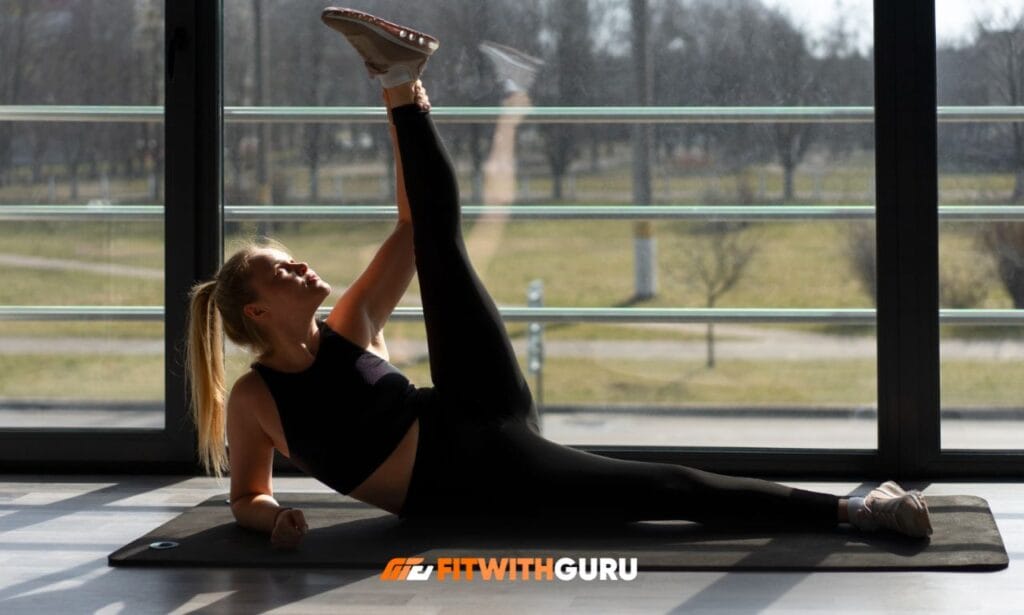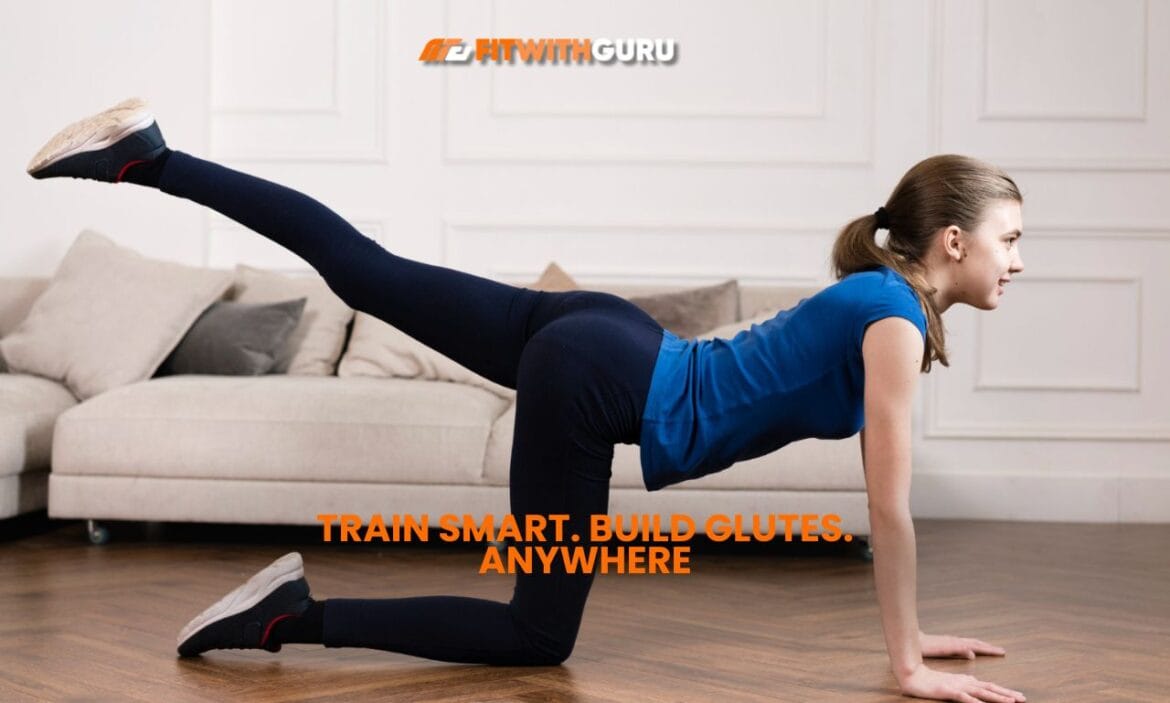As one of the largest muscle groups, the glutes are among the largest and most powerful, enabling movement, stability, and posture. Having strong glutes is extremely important for strength, endurance, and performance. As no equipment is necessary, bodyweight glute exercises can be done anywhere, making them a great option for targeting and developing this muscle group.
This guide goes further by showcasing the top 5 bodyweight glute exercises that need no equipment and enhance glute workouts by being effective and simple. These movements focus on priming and fortifying the glutes, improving muscle development, growth, and overall lower body strength. No matter your skill level, these movements are easily adjustable to align with your fitness and objectives.
Top 5 Bodyweight Glute Exercises
Achieving toned and defined gluteal muscles can be achieved through simple bodyweight exercises. No gym or exercise equipment is needed to perform these movements anywhere. Strong gluteal muscles are essential for movement, posture, and stability.
Whether shuttling from one place to another or staying home, bodyweight glute exercises offer tremendous value in sculpting the underlying musculature and strength of the lower body. The five exercises listed below rank among the best for working the glute muscles, sculpting, and enhancing overall strength.
All the movements are equipment-free, making them time-efficient and accessible to everybody. From novices to adept fitness devotees, the exercises are easily adjustable to all levels, making them perfect for improving muscular development, boosting athletic capabilities, and decreasing injury risk.
1. Glute Bridge
How to Perform It: The glute bridge is a simple yet powerful exercise that can be done anywhere.
- Begin by lying flat on your back with your knees bent and feet flat on the floor. Keep your feet about hip-width apart and your arms relaxed by your sides for stability.
- Press through your heels, engage your glutes, and lift your hips off the ground towards the ceiling. As you lift your hips, ensure your body forms a straight line from your shoulders to your knees.
- Hold this position for a brief moment, focusing on squeezing your glutes at the top, and then lower your hips back down slowly. Repeat for the desired number of reps.
Targeted Muscles: The glute bridge primarily targets the gluteus maximus, the largest muscle in your glutes. It also engages the hamstrings, which assist in the hip extension, and the lower back, providing a full posterior chain activation. It is also one of the best movements in bodyweight glute exercises.
Benefits: The glute bridge is highly effective at building glute strength, improving hip stability, and activating the posterior chain muscles, especially for individuals who sit for long periods. Regular exercise can also improve posture, reduce lower back discomfort, and help correct muscle imbalances, as it activates the glutes and strengthens them, counteracting the sedentary effects of daily life.
2. Single-Leg Glute Bridge
How to Perform It: The single-leg glute bridge is a more advanced version of the basic glute bridge that isolates one leg at a time.
- Begin by lying flat on your back with both knees bent and feet flat on the floor. Lift one leg off the ground, keeping your knee bent at about 90 degrees.
- Press through the heel of your standing leg to lift your hips towards the ceiling. Keep your core engaged and your pelvis stable as you lift. At the top of the movement, squeeze your glutes before slowly lowering your hips back down to the floor. Perform all repetitions on one leg, then switch to the other.

Targeted Muscles: The primary muscle in the single-leg glute bridge is the gluteus maximus of the working leg, which also engages the hamstrings, core, and lower back. By performing this exercise unilaterally, it forces each side to work independently, helping to identify and correct any imbalances between the left and right glutes.
Benefits: This exercise significantly enhances glute strength and activation, helping to target the gluteus maximus more effectively than the traditional bridge.
It also works on balance, coordination, and stability, making it excellent for improving athletic performance and lowering the risk of injury. The single-leg glute bridge also activates the core muscles, helping to improve overall core strength and hip stability, and is a good exercise in bodyweight glute exercises.
3. Curtsy Lunge
How to Perform it:
- The curtsy lunge is a dynamic lower body exercise that challenges the glutes and targets multiple muscle groups. Begin by standing with your feet hip-width apart.
- Step back to the side with your right leg, crossing it behind your left leg like a curtsy. As you lower your body, bend both knees to about 90 degrees, ensuring your front knee does not extend beyond your toes. Your back knee should hover just above the ground.
- Push through the heel of your front foot to return to the standing position, and then repeat the movement on the opposite leg. Continue alternating legs for the desired number of reps.
Targeted Muscles: The curtsy lunge targets the gluteus medius and gluteus maximus, quads, hamstrings, and inner thighs. The cross-body motion of the exercise emphasizes the outer glutes, and the movement engages the stabilizer muscles in the core, improving balance and coordination.
Benefits: The curtsy lunge is an effective bodyweight glute exercises for sculpting the glutes and improving muscle balance. It strengthens the glutes, helps tone the thighs, and improves functional mobility. It also enhances hip stability, which can translate into better posture and a reduced risk of injuries, especially during sports or activities requiring lateral movement.
4. Frog Pump
How to Perform it:
- The frog pump is a glute bridge variation focusing on targeting the glutes more intensely. To perform this exercise, lie flat on your back with your knees bent and the soles of your feet pressed together.
- Position your feet close to your body and spread your knees wide apart. Press through your heels and lift your hips off the ground, squeezing your glutes at the movement’s top.
- Hold for a moment at the top, then slowly lower your hips back down to the floor. Repeat the movement for the desired number of reps.
Targeted Muscles: The frog pump specifically targets the gluteus maximus, particularly the upper portion of the glutes. The wide-legged position emphasizes the outer glutes and helps activate the hip abductors. The inner thighs also contribute to the movement, providing a more comprehensive lower-body workout.
Benefits: The frog pump is excellent for isolating the glutes and increasing their activation during the exercise. It helps improve glute strength, muscle definition, and hip flexibility.

This exercise is particularly useful for targeting the upper glutes and can provide a unique challenge to your bodyweight glute exercises routine. Additionally, it improves hip mobility, which is essential for a well-rounded lower body workout.
5. Donkey Kick
How to Perform it:
- The donkey kick is a great exercise for isolating the glutes. Start in a tabletop position on all fours with your hands directly under your shoulders and knees under your hips.
- Keeping your knee bent at 90 degrees, lift one leg towards the ceiling, engaging your glutes as you extend your hip.
- Hold briefly at the top, focusing on squeezing your glutes, and then slowly lower your knee back down without touching the floor. Perform the desired reps on one side before switching to the other leg.
Targeted Muscles: The donkey kick primarily targets the gluteus maximus, responsible for the hip extension movement.
The hamstrings, lower back, and core are also engaged during the exercise, helping to stabilize the body as you lift your leg. This movement effectively isolates the glutes, providing an intense contraction at the top of the movement.
Benefits: The donkey kick is fantastic for strengthening and toning the glutes, especially the upper part of the gluteus maximus.
This exercise helps increase glute activation, improve hip mobility, and promote a lifted appearance of the bodyweight glute exercises. It’s also a great way to enhance lower body strength and can help reduce discomfort in the lower back by reinforcing proper hip extension.
Training Tips
Progression: To continue seeing progress in your glute development, it’s important to challenge yourself over time. It can be achieved by increasing the number of sets and repetitions or adding variations to these exercises.
For example, try incorporating isometric holds at the top of each movement, or progress to more advanced variations like single-leg versions or adding pulses. The key is to progressively overload the muscles to promote growth and strength.
Form Focus: Maintaining proper form is crucial to maximizing the effectiveness of these exercises and minimizing the risk of injury. Always ensure you activate your glutes throughout the movement, not relying on other muscles like your lower back.
Keep your core engaged to protect your spine and maintain balance. Also, avoid rushing through the bodyweight glute exercises; slow and controlled movements are often more effective for building muscle and improving muscle connection.
Consistency: Consistency is one of the most important factors in glute training. To see noticeable improvements in strength, tone, and muscle growth, aim to perform these exercises 2-3 times a week.
Over time, the muscles will adapt and grow stronger, but the key to achieving lasting results is sticking with your routine and gradually increasing the intensity. Patience and consistency will pay off through a stronger, more sculpted lower body.

FAQs
1. How often should I perform bodyweight glute exercises to see results?
Aim to perform bodyweight glute exercises 2-3 times weekly to see noticeable results. Consistency is key; allowing your muscles to recover between sessions will help prevent overtraining. As you progress, gradually increase the intensity or number of sets and reps to continue challenging your glutes.
2. Can I build muscle with bodyweight glute exercises alone?
You can build muscle with bodyweight glute exercises, especially if you consistently challenge your muscles and focus on proper form. While weight training can accelerate muscle growth, bodyweight exercises can still be highly effective with adequate progression, intensity, and consistency.
3. Are bodyweight glute exercises suitable for beginners?
Absolutely! Bodyweight glute exercises are ideal for beginners because they require no equipment and can be modified to fit your fitness level. Start with basic exercises like glute bridges and gradually progress to more challenging movements as your strength and endurance improve.
Conclusion
The bodyweight glute exercises are an effective and accessible way to build strength, enhance muscle tone, and improve overall lower body performance. Exercises like the glute bridge, single-leg glute bridge, curtsy lunge, frog pump, and donkey kick target the glutes from various angles, ensuring balanced development and increased activation.
Consistency and proper form are essential to making progress, and with time, you’ll see noticeable improvements in strength and appearance. Stay committed, challenge yourself, and remember that with dedication, you’ll achieve the strong, sculpted legs you’re working toward with these bodyweight glute exercises.

